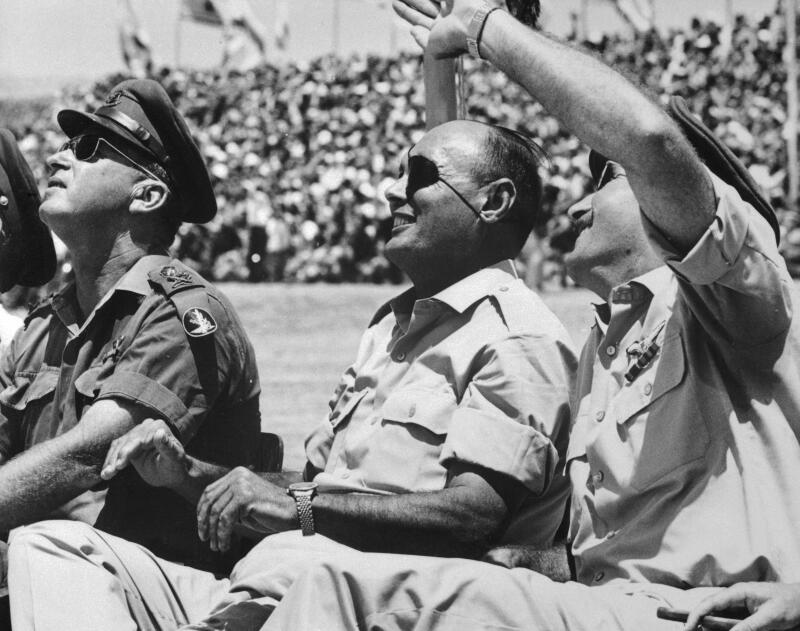The two Israeli politicians long ago laid down the terms of Israel’s dilemma about Gaza

Israeli chiefs watch an air show over the Negev Brigade Monument in celebration of Israel’s military victory in the 6-Day War with Egypt, Jordan, and Syria. From left to right are; Chief of Staff Itzhak Rabin, Defense Minister Moshe Dayan, and Chief of the Israeli Air Force Mordechai Hod.
6 November 2023 — There was an interesting presentation over the weekend by Sciences Po Paris which I will try to summarize.
The Nahal Oz kibbutz, in the northeast of the Gaza Strip, was one of the sites martyred by Hamas’s terrorist offensive on October 7th. In 1951, it was the first settlement of the “Fighting Pioneer Youth,” whose Hebrew acronym is Nahal. The Nahal program, conceived by David Ben-Gurion in the wake of the first Arab-Israeli war of 1948-1949, aimed to anchor both civilian and militarized outposts in the most sensitive border areas.
In April 1956, one of Nahal Oz’s guards, Roi Rothberg, was murdered by Palestinian infiltrators from Gaza. Given the level of shock in Israel at the time, Chief of the General Staff Moshe Dayan came to Nahal Oz in person to deliver a eulogy, the words of which have particular resonance in today’s tragedy.
‘Sea of hatred and vengeance’
“Let us not hurl blame at the murderers. Why should we complain of their hatred for us? Eight years have they sat in the refugee camps of Gaza, and seen, with their own eyes, how we have made a homeland of the soil and the villages where they and their forebears once dwelt. Not from the Arabs of Gaza must we demand the blood of Roi, but from ourselves.” The chief of the General Staff urged his compatriots never to forget that “beyond the furrow that marks the border, lies a surging sea of hatred and vengeance.”
In November 1956, Israeli troops occupied the Gaza Strip with the declared aim of eliminating the presence of the fedayeen, as the Palestinian fighters were called. During the four months of occupation, a thousand Gazans – one in every 300 – died.
Ten years later, Dayan, then minister of defense, once again seized the Gaza Strip, with Yitzhak Rabin as chief of the General Staff. The two heroes of the June 1967 Six-Day War were in favor of an occupation without colonization. Dayan ordered the removal of all visible separation between Israel and the Palestinian territory, whose population was encouraged to work in Israel, soon making those wages Gaza’s main resource.
Dayan joined Menachem Begin’s government as foreign minister after Likud’s historic victory over Labor in May 1977. But Begin concluded peace with Egypt in March 1979 only to be able to colonize the West Bank and Gaza, forcing Dayan to resign. Likud’s hard-line stance eventually led to the emergence of a pro-peace movement in Israel, which won the June 1992 elections under the leadership of Labor’s Rabin.
‘Negotiate as if there were no terrorism’
Rabin may have reached a peace agreement with Yasser Arafat and his Palestine Liberation Organization (PLO) in September 1993, but he was adamant that terrorism had to be fought as if there were no negotiations, and to negotiate as if there were no terrorism. Rabin, who fell victim to the bullets of a Jewish terrorist in November 1995, was convinced that talks were bound to take place, even in the midst of violence, precisely to extinguish that violence.
Ariel Sharon, swept to power in February 2001 by an electoral landslide against a backdrop of Palestinian suicide bombings, compared Arafat to Bin Laden in the same terms that Netanyahu now equates Hamas with the Islamic State. He abandoned all negotiations to establish what he saw as secure borders for Israel, with the separation wall in the West Bank and the unilateral withdrawal from Gaza. And so much worse if Hamas thus took control of the Gaza Strip in June 2007, a control reinforced by the 16-year blockade imposed on the Palestinian enclave ever since.
Netanyahu’s declared aim with the current ground operations in Gaza is the same as Dayan’s in 1956: the eradication of armed Palestinian groups, through methodical combing and systematic wipeout. But although this goal was achieved in 1956, at the cost of a very heavy human toll, it did nothing to resolve the underlying problem, inexorably sparking a resurgence of Palestinian supporters of the armed struggle.
Far from diminishing over time, the antagonism has hardened to the benefit of extremists on both sides, leading to the horror of the current catastrophe. That’s why it’s essential to ponder the lessons of the past, and above all to avoid repeating the same mistakes, on an even more appalling scale. Sharon’s unilateral separation has set the scene for the ongoing disaster. What remains is the alternative between the war assumed by Dayan in 1956 or the negotiation advocated by Rabin, while continuing to fight the enemy, with no illusions about the possibility of a general reconciliation.